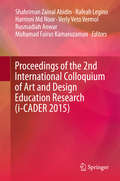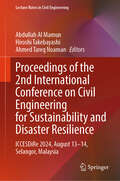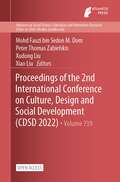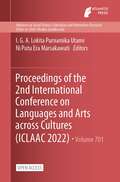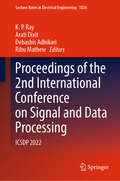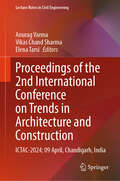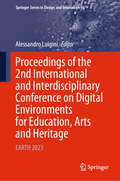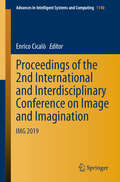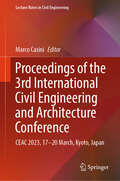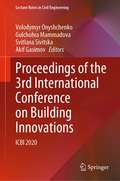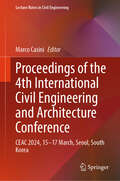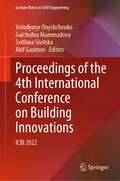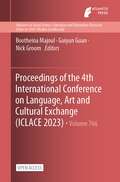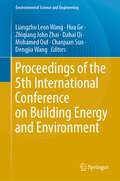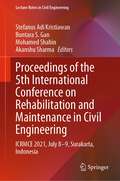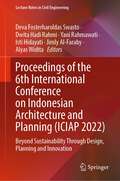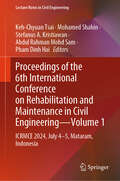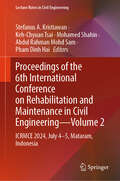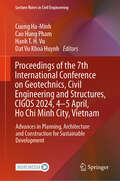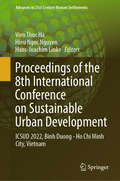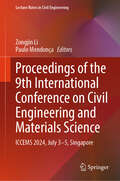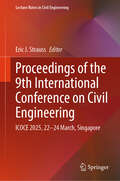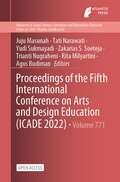- Table View
- List View
Proceedings of the 2nd International Colloquium of Art and Design Education Research (i-CADER #2015)
by Shahriman Zainal Abidin Rusmadiah Anwar Muhamad Fairus Kamaruzaman Rafeah Legino Harrinni Md Noor Verly Veto VermolThis book features 66 papers from the 2nd International Colloquium of Art and Design Education Research, i-CADER 2015. It illustrates the wide range of opinions and interpretations, mediums and technologies, policies and methodologies in this field. The papers, which have been reviewed by 380 experts from around the world, underline the latest trans-disciplinary research in art and design education. Coverage examines organization and sustainable issues, including: creative processes, knowledge and experience, design industrial applications, sustainable design, visual communication and new media, art education research, cultural studies, teaching and learning implications on art, traditional knowledge, and new technologies for industries. In addition, the volume also explores innovative research trends in cross-disciplinary findings, combining methodology and theory. Overall, readers are provided with an insightful analysis of the latest research and advances in art and design education.
Proceedings of the 2nd International Conference on Civil Engineering for Sustainability and Disaster Resilience: ICCESDiRe 2024, August 13–14, Selangor, Malaysia (Lecture Notes in Civil Engineering #668)
by Abdullah Al Mamun Hiroshi Takebayashi Ahmed Tareq NoamanThis book covers a wide range of topics, including sustainable infrastructure development, disaster risk reduction, climate change adaptation, and resilient construction practices. The "International Conference on Civil Engineering for Sustainability and Disaster Resilience" (ICCESDiRe 2024) proceedings book presents a collection of cutting-edge research and innovative practices in civil engineering aimed at promoting sustainability and enhancing disaster resilience. The proceedings also feature discussions on the integration of sustainable development goals (SDGs) into civil engineering practices, emphasizing the need for interdisciplinary approaches and stakeholder engagement. Overall, this proceedings book serves as a valuable resource for researchers, practitioners, and policymakers interested in advancing sustainable development and disaster resilience through civil engineering. It provides insights into current trends, challenges, and opportunities in the field, offering practical solutions and strategies for building a more sustainable and resilient future.
Proceedings of the 2nd International Conference on Culture, Design and Social Development (Advances in Social Science, Education and Humanities Research #739)
by Xiao Liu Mohd Fauzi bin Sedon M. Dom Peter Thomas Zabielskis Xudong LiuThis is an open access book. Culture is the spiritual activity and product of human society relative to economy and politics. The traditional concept of human beings believes that culture is a social phenomenon, a product created by human beings for a long time, and at the same time a historical phenomenon, which is the accumulation of human society and history.The technical, economical and cultural nature of art design determines that only with high social and economic development can art and culture flourish. Art design is the product of the combination of art and technology. Art design is also a kind of productivity, which promotes the development of social economy. As a driving factor for social and economic development, design art will also better serve the social economy with its own more perfect operating system.The 2nd International Conference on Culture, Design and Social Development (CDSD 2022) was held in Nanjing from December 2 to 4, 2022. The purpose of the conference is to provide an international platform for experts, scholars, engineers and technicians, and technical R&D personnel engaged in related fields such as "culture", "design" and "social development", to share scientific research results, broaden research ideas, collide with new ideas, and strengthen academic research, and to explore the key challenges and research directions faced by the development of this field, and promote the industrialization cooperation of academic achievements. Experts, scholars, business people and other relevant personnel from universities and research institutions at home and abroad are cordially invited to attend and exchange.
Proceedings of the 2nd International Conference on Languages and Arts across Cultures (Advances in Social Science, Education and Humanities Research #701)
by I. G. A. Lokita Purnamika Utami Ni Putu Era MarsakawatiThis is an open access book. The 2nd International Conference on Languages and Arts across Cultures (ICLAAC) aims to provide a venue for lecturers, teachers, researchers, as well as language and art professionals to share their insights, experiences, and ideas. This conference will also bridge the knowledge gap by presenting their works on languages and arts issues. The event will provide limitless resources and opportunities to interact with prominent scholars in this field worldwide. This will allow us to significantly expand our existing global network.The conference theme will give us a better understanding of humans through languages and arts. The development of cultural value occurring in today's global communities is certainly a stimulant for artist and language users in creating their artifacts.Restoring cross-cultural understanding is a bridge to understanding the complexities of language, culture, and the role of art in them. Cross-cultural understanding refers to people's attempts to understand one another, particularly between people of different cultural backgrounds. Significant cultural and artistic creations are incorporated into a language that promotes scholarly debate and scientific comprehension. As an attempt to minimize the spread of covid-19 virus, the conference presenters will be invited to present their papers online via zoom.
Proceedings of the 2nd International Conference on Signal and Data Processing: ICSDP 2022 (Lecture Notes in Electrical Engineering #1026)
by K. P. Ray Debashis Adhikari Arati Dixit Ribu MathewThis volume comprises the select proceedings of the 2nd International Conference on Signal & Data Processing (ICSDP) 2022. The contents focus on the latest research and developments in the field of artificial intelligence & machine learning, Internet of things (IoT), cybernetics, advanced communication systems, VLSI embedded systems, power electronics and automation, MEMS/ nanotechnology, renewable energy, bioinformatics, data acquisition and mining, antenna & RF systems, power systems, biomedical engineering, aerospace & navigation. This volume will prove to be a valuable resource for those in academia and industry.
Proceedings of the 2nd International Conference on Trends in Architecture and Construction: ICTAC-2024; 09 April, Chandigarh, India (Lecture Notes in Civil Engineering #527)
by Anurag Varma Vikas Chand Sharma Elena TarsiThis book includes peer reviewed article from the 2nd International Conference on Trends in Architecture and Construction (ICTAC-2024) held at Chandigarh in India. It explores modernity, sustainability, technology, and education within the ever-evolving architectural landscape. This book echoes a collective dedication to fostering environmentally conscious urban practices. It navigates the symbiotic relationship between technology and architecture, shining a spotlight on the pivotal roles of AI, digital tools, and cutting-edge construction techniques. Beyond the tangible, the publication illuminates the shifting terrain of architectural education, honing in on emerging research paradigms and the integration of innovative pedagogies. Rooted in sustainability, this compendium stands as a vibrant repository of insightful contributions, nurturing an expansive dialogue on the future trajectory of architecture.
Proceedings of the 2nd International and Interdisciplinary Conference on Digital Environments for Education, Arts and Heritage: EARTH 2023 (Springer Series in Design and Innovation #36)
by Alessandro LuiginiThis book gathers peer-reviewed papers presented at the International and Interdisciplinary Conference on Digital Environments for Education, Arts and Heritage (EARTH2023), held in Brixen, Italy, in June 2023. The papers focus on interdisciplinary and multi-disciplinary research concerning cutting-edge cultural heritage informatics and engineering; the use of technology for the representation, preservation and communication of cultural heritage knowledge; as well as heritage education in digital environments; innovative experiments in the field of digital representation and methodological reflections on the use of IT tools in various educational contexts. The scope of the papers ranges from theoretical research to applications, including education, in several fields of science, technology and art. EARTH 2018 addressed a variety of topics and subtopics, including digital representation technologies, virtual museums and virtual exhibitions, virtual and augmented reality, digital heritage and digital arts, art and heritage education, teaching and technologies for museums, VR and AR technologies in schools, education through digital media, psychology of perception and attention, psychology of arts and communication, as well as serious games and gamification. As such the book provides architects, engineers, computer scientists, pedagogist, psychologist, social scientists and designers interested in computer applications and cultural heritage with an overview of the latest advances in the field, particularly in the context of science, arts and education.
Proceedings of the 2nd International and Interdisciplinary Conference on Image and Imagination: IMG 2019 (Advances in Intelligent Systems and Computing #1140)
by Enrico CicalòThis book gathers peer-reviewed papers presented at the 1st International and Interdisciplinary Conference on Image and Imagination (IMG 2019), held in Alghero, Italy, in July 2019. Highlighting interdisciplinary and multi-disciplinary research concerning graphics science and education, the papers address theoretical research as well as applications, including education, in several fields of science, technology and art. Mainly focusing on graphics for communication, visualization, description and storytelling, and for learning and thought construction, the book provides architects, engineers, computer scientists, and designers with the latest advances in the field, particularly in the context of science, arts and education.
Proceedings of the 3rd International Civil Engineering and Architecture Conference: CEAC 2023, 17-20 March, Kyoto, Japan (Lecture Notes in Civil Engineering #389)
by Marco CasiniThis book collects the scientific proceedings presented during the "2023 The 3rd International Civil Engineering and Architecture Conference” held in Kyoto in March 2023 with the aim of showing the latest advancements in theoretical and applied research in the architecture, engineering, and construction (AEC) sector. Worldwide, the growing demand is for green and smart buildings that are perfectly integrated into the surrounding environment, have efficient energy and resource consumption, use environmentally friendly materials and renewable energies, favor recycling and reuse, and offer improved indoor comfort and air quality. The book provides readers with an overview of the ongoing transformation of the AEC industry presenting a thorough investigation of the emerging trends and challenges in the fields of green building design, construction and operation. Its content caters to researchers, engineers and architects working in the field of theoretical, experimental and practical civil engineering and architecture.
Proceedings of the 3rd International Conference on Building Innovations: ICBI 2020 (Lecture Notes in Civil Engineering #181)
by Volodymyr Onyshchenko Gulchohra Mammadova Svitlana Sivitska Akif GasimovThis book gathers the latest advances, innovations, and applications in the field of building design and construction, by focusing on new design solutions for buildings and new technologies creation for construction, as presented by researchers and engineers at the 3rd International Conference Building Innovations (ICBI), held in Poltava – Baku, Ukraine – Azerbaijan, on June 1-2, 2020. It covers highly diverse topics, including structures operation, repairing and thermal modernization in existing buildings and urban planning features, machines and mechanisms for construction, as well as efficient economy and energy conservation issues in construction. The contributions, which were selected by means of a rigorous international peer-review process, highlight numerous exciting ideas that will spur novel research directions and foster multidisciplinary collaborations.
Proceedings of the 4th International Civil Engineering and Architecture Conference: CEAC 2024, 15–17 March, Seoul, South Korea (Lecture Notes in Civil Engineering #534)
by Marco CasiniThis book collects the scientific proceedings presented during the “2024 The 4th International Civil Engineering and Architecture Conference” held in Seoul, South Korea, in March 2024 with the aim of showing the latest advancements in theoretical and applied research in the architecture, engineering, and construction sector (AEC). The book is organized into four main parts, namely (1) sustainable urban planning and architecture; (2) architectural and environmental design; (3) built environment materials and construction technology; and (4) civil engineering and construction management. The goal of the book is to provide readers with an overview of the ongoing transformation of the AEC industry presenting a thorough investigation of the emerging trends in the fields of green building design, construction, and operation.
Proceedings of the 4th International Conference on Advances in Civil and Ecological Engineering Research: ACEER2022 (Lecture Notes in Civil Engineering #292)
by Chih-Huang WengThis book presents select proceedings of the 4th International Conference on Advances in Civil and Ecological Engineering Research (ACEER 2022). The book covers a wide range of topics, including construction engineering and management hydraulic and hydrologic engineering, air quality and atmospheric pollution, ecological risk assessment and management, restoration and protection of environment, water pollution and treatment, and water recourses engineering. This book also covers state-of-the-art technologies in building sustainable city, resilient buildings, and sustainable issues in relating to civil engineering. It will be useful for researchers and engineers working in the field of civil and ecological engineering.
Proceedings of the 4th International Conference on Building Innovations: ICBI 2022 (Lecture Notes in Civil Engineering #299)
by Volodymyr Onyshchenko Gulchohra Mammadova Svitlana Sivitska Akif GasimovThis book gathers the latest advances, innovations, and applications in the field of building design and construction, by focusing on new design solutions for buildings and new technologies creation for construction, as presented by researchers and engineers at the 4th International Conference Building Innovations (ICBI), held in Poltava – Baku, Ukraine – Azerbaijan, on May 19-20, 2022. It covers highly diverse topics, including structures operation, repairing and thermal modernization in existing buildings and urban planning features, machines and mechanisms for construction, as well as efficient economy and energy conservation issues in construction. The contributions, which were selected by means of a rigorous international peer-review process, highlight numerous exciting ideas that will spur novel research directions and foster multidisciplinary collaborations.
Proceedings of the 4th International Conference on Language, Art and Cultural Exchange (Advances in Social Science, Education and Humanities Research #766)
by Nick Groom Guiyun Guan Bootheina MajoulThis is an open access book.The 4th International Conference on Language, Art and Cultural Exchange (ICLACE 2023) will be held on May 19–21, 2023 in Hangzhou, China. Culture includes language, which is a special cultural phenomenon. For culture, most scholars agree that it mainly includes two aspects: material culture and spiritual culture. Specific examples to show cultural phenomena will be of great benefit to our understanding. Some examples of material culture are listed here: Indian women wear saris, Japanese like to eat sashimi, and Chinese like to shake hands when meeting each other. These are various manifestations of material culture in different nations.Language is the mode of transmission of culture. Language is one of the most important ways of thinking and cultural exchange of human beings, which is actually the manifestation of the formation and transmission of culture. Because of thinking, human beings gradually create culture in the continuous social practice, and then spread their national culture to each other in the continuous language exchange.Since ancient times, art and culture have been going hand in hand and complementing each other. On the one hand, art is an important connotation and component of culture, and the progress of art is the driving force of cultural development. On the other hand, culture is the source and content of art, and the prosperity of culture is the key to improve the level of art. On the other hand, culture is the source and content of art, and the prosperity of culture is the key to improving the level of art. Therefore, whether it is culture or art, it is not only a symbol of an era, a representation of people’s life style, but also a guide to the direction of social development.The relationship between language, art and cultural communication is a hot topic for many scholars to study at present. Therefore, an academic conference is set up for authors to discuss related research issues and exchange new ideas, hoping that scholars can burst out more excellent and valuable ideas in this conference.ICLACE 2023 is to bring together innovative academics and industrial experts in the field of Literature, Art and Cultural Exchange research to a common forum. The primary goal of the conference is to provide a platform for scientists, scholars, and engineers from all over the world to present ongoing research activities, fostering the research and business relations and promoting scientific information interchange and cooperation between all the participants.
Proceedings of the 5th International Conference on Building Energy and Environment (Environmental Science and Engineering)
by Hua Ge Zhiqiang John Zhai Liangzhu Leon Wang Dahai Qi Mohamed Ouf Chanjuan Sun Dengjia WangThis book is a compilation of selected papers from the 5th International Conference on Building Energy and Environment (COBEE2022), held in Montreal, Canada, in July 2022. The work focuses on the most recent technologies and knowledge of building energy and the environment, including health, energy, urban microclimate, smart cities, safety, etc. The contents make valuable contributions to academic researchers, engineers in the industry, and regulators of buildings. As well, readers encounter new ideas for achieving healthy, comfortable, energy-efficient, resilient, and safe buildings.
Proceedings of the 5th International Conference on Rehabilitation and Maintenance in Civil Engineering: ICRMCE 2021, July 8-9, Surakarta, Indonesia (Lecture Notes in Civil Engineering #225)
by Buntara S. Gan Stefanus Adi Kristiawan Mohamed Shahin Akanshu SharmaThis book is a collection of papers presented at the 5th International Conference on Rehabilitation and Maintenance in Civil Engineering (ICRMCE 2021), held in Surakarta, Indonesia. The papers are grouped into sequential themes representing the structure of this book: o Part 1: Factors affecting building and infrastructure performance o Part 2: Testing and inspection of existing building and infrastructure o Part 3: Protection, maintenance, repair, and retrofitting of building and infrastructure o Part 4: Maintenance management of building and infrastructure o Part 5: Service life modelling of building and infrastructure o Part 6: Hazard mitigation o Part 7: Sustainability aspect in civil engineering design, process, modelling, maintenance, and rehabilitation Postgraduate students, researchers, and practitioners specializing and working in the area of protection, maintenance, repair, and retrofitting of civil engineering infrastructures will find this book very useful.
Proceedings of the 6th International Conference on Indonesian Architecture and Planning: Beyond Sustainability Through Design, Planning and Innovation (Lecture Notes in Civil Engineering #334)
by Deva Fosterharoldas Swasto Dwita Hadi Rahmi Yani Rahmawati Isti Hidayati Jimly Al-Faraby Alyas WiditaThis book presents selected papers from the 6th International Conference on Indonesian Architecture and Planning (ICIAP) held during October 13-14 2022 at the Universitas Gadjah Mada, Yogyakarta, Indonesia. The ICIAP is a series of biennale conferences which presents the latest developments in the field of Indonesian architecture, planning, and the governance. Each edition of the conference focuses in a specific theme, and it provides an exclusive forum for intellectually stimulating and engaging interactions among academicians and industrialists to share their recent scientific breakthroughs and emerging trends. For ICIAP 2022, the conference theme focused on “Beyond Sustainability in Design, Planning, and Innovation” and papers presented on relevant topics such as sustainable urban and regional development, sustainable architectural design, innovations for sustainability, responsive environment and challenges for sustainability. The content of this book will appeal to the researchers, academics, urban planners and policymakers who work in the field of sustainable architecture design, planning and innovation.
Proceedings of the 6th International Conference on Rehabilitation and Maintenance in Civil Engineering—Volume 1: ICRMCE 2024, July 4–5, Mataram, Indonesia (Lecture Notes in Civil Engineering #625)
by Mohamed Shahin Keh-Chyuan Tsai Stefanus A. Kristiawan Abdul Rahman Mohd Sam Pham Dinh HaiBook presents selected papers from the 6th International Conference on Rehabilitation and Maintenance in Civil Engineering (6th ICRThis MCE) on July 4–5, 2024, at Mataram, Indonesia. The papers covers topics related to developing and maintaining a sustainable built environment to mitigate the environmental impacts of human activities and create a healthier and more resilient future. This is achieved through infrastructure development and maintenance issues from various perspectives and is brought together under the theme of policy, design, construction, rehabilitation and maintenance for a sustainable built environment. Readers will gain a deeper understanding of how to identify and solve issues related to infrastructure design, construction, use and maintenance toward realizing a sustainable built environment by tapping into various fields' expertise within civil engineering such as material, structural, geotechnical, transportation, water resources and construction management.
Proceedings of the 6th International Conference on Rehabilitation and Maintenance in Civil Engineering—Volume 2: ICRMCE 2024, July 4–5, Mataram, Indonesia (Lecture Notes in Civil Engineering #598)
by Mohamed Shahin Keh-Chyuan Tsai Stefanus A. Kristiawan Abdul Rahman Mohd Sam Pham Dinh HaiThis book presents selected papers from the 6th International Conference on Rehabilitation and Maintenance in Civil Engineering (6th ICRMCE) on July 4–5, 2024, at Mataram, Indonesia. The papers cover topics related to developing and maintaining a sustainable built environment to mitigate the environmental impacts of human activities and create a healthier and more resilient future. This is achieved through infrastructure development and maintenance issues from various perspectives and is brought together under the theme of policy, design, construction, rehabilitation, and maintenance for a sustainable built environment. Readers will gain a deeper understanding of how to identify and solve issues related to infrastructure design, construction, use, and maintenance toward realizing a sustainable built environment by tapping into various fields' expertise within civil engineering such as material, structural, geotechnical, transportation, water resources, and construction management.
Proceedings of the 7th International Conference on Geotechnics, Civil Engineering and Structures, CIGOS 2024, 4-5 April, Ho Chi Minh City, Vietnam: Advances in Planning, Architecture and Construction for Sustainable Development (Lecture Notes in Civil Engineering #482)
by Cuong Ha-Minh Dat Vu Khoa Huynh Cao Hung Pham Hanh T. H. VuThis book includes peer-reviewed articles from the 7th International Conference on Geotechnics, Civil Engineering and Structures (CIGOS 2024) held on April 4-5 in Ho Chi Minh City, Vietnam. It highlights recent advances in planning, architecture, and construction for sustainable development. The book features a compilation of articles presented at the conference, bringing together researchers, academics, and practitioners from around the world. The topics covered range from Planning, Architecture, and Industrial Design to Construction, Materials, Structures, and Digital Technologies, as well as Geoscience, Environment, and Energy, and Transportation, Infrastructure, Management, and Investment. The book emphasizes the importance of a multidisciplinary approach to sustainable development in order to address environmental, social, and economic challenges faced by societies worldwide. It provides insights into best practices and innovative approaches for achieving sustainabledevelopment goals, such as reducing the carbon footprint, enhancing energy efficiency, promoting the use of eco-friendly materials, and implementing sustainable construction techniques. Overall, this book offers valuable knowledge and advice to professionals, researchers, and policymakers engaged in sustainable development initiatives.
Proceedings of the 8th International Conference on Sustainable Urban Development: ICSUD 2022, Binh Duong - Ho Chi Minh City, Vietnam (Advances in 21st Century Human Settlements)
by Hans-Joachim Linke Vien Thuc Ha Hieu Ngoc NguyenThis book includes peer-reviewed articles from the 8th International Conference on Sustainable Urban Development (ICSUD 2022), held at the Vietnamese-German University (VGU) in Vietnam. The theme of the conference is “innovative and inclusive growth models for sustainable urban development”. Articles in this book present major issues that cities and regions around the world are facing these days to adapt to new, unexpected, and profound challenges.Over past few years, the world has been observing meaningful reactions to crises. From the pandemic to war, energy, and food shortages, there are always opportunities for innovations. Some firms still thrived in the city lock-down; some groups stayed healthier with less income; and certain municipalities consumed less resources to attain higher outcomes. However, the rise of digital economy, the importance of proximity or near-shore supply chain, or the new contribution of different communities at different levels are generalized asnew growth models for changes.
Proceedings of the 9th International Conference on Civil Engineering and Materials Science: ICCEMS 2024, July 3–5, Singapore (Lecture Notes in Civil Engineering #427)
by Zongjin Li Paulo MendonçaThis book includes the selected contributions from the 9th International Conference on Civil Engineering and Materials Science (ICCEMS 2024), held in Singapore from July 3–5, 2024.This book showcases the latest research and developments in the field, presenting a valuable resource for researchers, professionals, and students alike. ICCEMS 2024 selected contributions featured in this book cover a wide range of topics, including structural engineering, geotechnical engineering, materials science and engineering, sustainable infrastructure, and other related scopes. Whether readers are researchers seeking the latest advancements, professionals looking for practical insights, or students eager to explore the frontiers of the discipline, this book is an indispensable resource that will enrich readers understanding and contribute to the advancement of the field.
Proceedings of the 9th International Conference on Civil Engineering: ICOCE 2025, 22–24 March, Singapore (Lecture Notes in Civil Engineering #714)
by Eric J. StraussThis book comprises the latest collection of peer reviewed research articles presented at the 9th International Conference on Civil Engineering, ICOCE 2025, held in Singapore from March 22 to 24. The proceedings focus on the state-of-the-art findings on topics of civil engineering and related fields. Engineering solutions are treated from a global perspective. Highlighted fields of inquiry include concrete technology, computer simulations, construction and engineering management, building materials, and architecture and urban planning. The authors outline solutions to physical, natural resource, and economic problems in many different contexts. This volume consists of refereed articles authored by a wide variety of international researchers and practitioners from many perspectives discussing current research solutions that involve problems in civil and environmental engineering. Examples that cover municipal development, transportation engineering, pollution control, and public safety are prominently featured. The chapters contain a diverse collection of applications that appeal to individuals with all levels of knowledge and interest in the important issues relevant to international engineering.
Proceedings of the Fifth International Conference on Arts and Design Education (Advances in Social Science, Education and Humanities Research #771)
by Juju Masunah Tati Narawati Yudi Sukmayadi Zakarias S. Soeteja Trianti Nugraheni Rita Milyartini Agus BudimanThis is an open access book.The 5th INTERNATIONAL CONFERENCE ON ARTS AND DESIGN EDUCATION (ICADE)“Digital Media Literacy and Mastery of Post-pandemic in Arts and Design Education” BACKGROUNDThe past year has been one of enormous turbulence and upheaval where nobody has been left untouched by the impact of the global pandemic, even a great change has been forced upon artists and educators in their work creation process as well as learning and teaching practice. What and how artists and educators have thought and gone through to keep their field sustained should be disseminated as a mutual learning to enhance our awareness on arts and design sustainability and role during pandemic. ICADE 5 aims to bring together leading academic artists, arts and design researchers and scholars to exchange and share their notion, experiences, and research results on all aspects of Digital Media Literacy and Mastery in Arts and Design education during pandemic and its urgencies after pandemics. It also provides a premier interdisciplinary platform for arts and design researchers, practitioners, and educators to present and discuss the most recent innovations, trends, and concerns as well as practical challenges encountered and solutions adopted which involves digital media literacy or mastery in the fields of Arts and Design education. The 5th International Conference on Arts and Design Education (ICADE) is a conference hosted by Faculty of Arts and Design Education Universitas Pendidikan Indonesia. This conference will be held on September 22nd, 2022 through Zoom Webinar. ICADE has covered a broad range of topic on music, dance, drama, visual arts, visual communication design, arts education, film and television, and multidiciplinary arts fields. This conference scopes may pertain how artist, designer, or arts and design educators finally adapt and conquer digital media to support their work creation and studies activities during pandemic; attitude changes toward art and design works creation; best practice of art and design creation and studies during pandemic; sorts of digital media which might be left or continuously used after pandemic; what finally the digital media can't ever cover during pandemic even to this moment (post-pandemic); potential disruptive/constructive point of digital media use; as well as other substance where we spot a relation between a digital media with arts and design creation and studies.
Proceedings of the First Mandalika International Multi-Conference on Science and Engineering 2022, MIMSE 2022 (Advances in Engineering Research #215)
by Buan Anshari Mohammed Ali Elsageer Hilton Ahmad Wen-Shao ChangThis is an open access book. The covid-19 pandemic today forces humans to do almost all activities from home. Consequently, inventions in many fields of engineering technology are needed to facilitate those activities. First, human activities mainly are based on information technology today and internet connection is very important. People generate, send, and receive data by their smartphones every time and everything is connected to the internet. Equipment becomes smarter to assist the owner. Second, People need powerful, efficient, and smart vehicles and machines in Industry 4.0. Third, the need for energy increases, which causes the decrease of global environmental quality. It needs new technology for saving energy by discovering new technologies in mechanical engineering. Fourth, many technologies emerge as disaster prevention by developing innovations in civil engineering and architecture.The Engineering Faculty of University of Mataram invites engineers and researchers around the world to visit Lombok island and to attend the valuable multi fields conference on science and engineering named “The First Mandalika International Multi-conference on Science and Engineering 2022″ or “1st MIMSE 2022”. This fruitful event will be the annual conference in Lombok island which is supported by the West Nusa Tenggara Province government. Initially, the 1st MIMSE 2022 consisted of 5 engineering fields are Civil, Architecture, Electrical, Mechanical, and Informatics Engineering.
